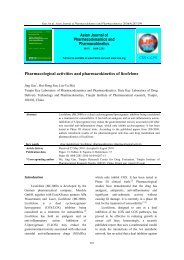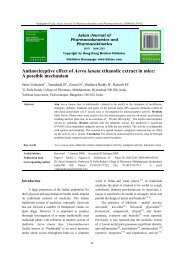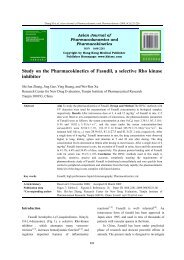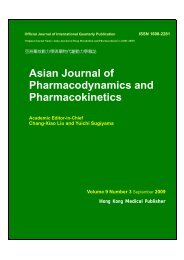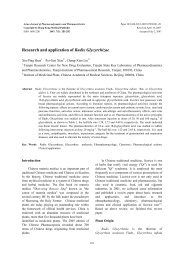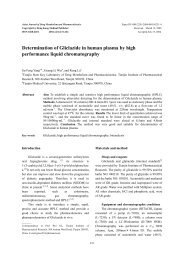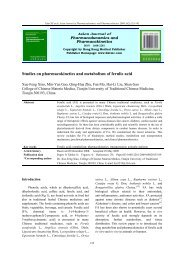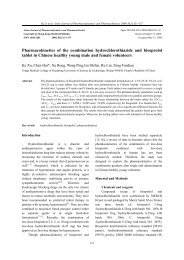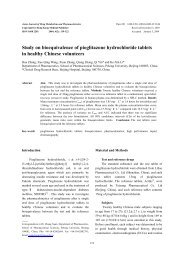Asian Journal of Pharmacodynamics and Pharmacokinetics
Asian Journal of Pharmacodynamics and Pharmacokinetics
Asian Journal of Pharmacodynamics and Pharmacokinetics
You also want an ePaper? Increase the reach of your titles
YUMPU automatically turns print PDFs into web optimized ePapers that Google loves.
volume <strong>of</strong> distribution (Vd), Calcium calmodilin<br />
dependent protein kinase (CCDPK).<br />
Manuscript Preparation<br />
Type the manuscript on white bond paper (A4) with<br />
broad margins. Use double spacing through out. Organize<br />
the manuscript in the order indicated below, with the page<br />
number typed in the upper right-h<strong>and</strong> corner <strong>of</strong> each page.<br />
Title Page Page 1 should include: (1) the title <strong>of</strong><br />
the article (80 characters maximum); (2) full name(s) <strong>of</strong><br />
author(s); (3) affiliations (job title, department,<br />
institution,city, <strong>and</strong> state or country) indicating which<br />
authors are associated with which affiliations; <strong>and</strong> (4)<br />
Footnotes may include the name <strong>and</strong> address <strong>of</strong> the author<br />
to whom reprint requests are to be sent, <strong>and</strong><br />
correspondence to which author, phone, Fax, <strong>and</strong> E-mail,<br />
as well as source <strong>of</strong> financial support..<br />
Abstract <strong>and</strong> Key Words Page 2 should include<br />
the title <strong>of</strong> the article followed by the abstract, which<br />
should be about 200 words. The abstract should<br />
summarize the main points <strong>of</strong> the article. The abstract in<br />
structured form consists <strong>of</strong> Aim (the purpose <strong>of</strong> the study),<br />
Methods (basic proedures), Results (main findings with<br />
main data) <strong>and</strong> Conclusions. Following the abstract, list<br />
4-8 key words for indexing.<br />
Text<br />
Papers should be organized in the following format:<br />
Introduction, Materials <strong>and</strong> methods, Results, discussion,<br />
<strong>and</strong> references.<br />
Introduction<br />
summarizes the rationale <strong>and</strong> gives a concise<br />
background. Use references to provide the most salient<br />
background rather than an exhaustive review. The last<br />
sentence should state tersely your purpose to do this study.<br />
An uncommon or new compound should be identified by<br />
the chemical name <strong>and</strong> structural formula.<br />
Materials <strong>and</strong> methods<br />
Materials International Nonproprietary Names<br />
(INN) or generic names should be employed whenever<br />
possible. If necessary, the proprietary name may be added<br />
once, in parentheses. The first letter <strong>of</strong> the drug name<br />
should be small for INN or generic names, but capitalized<br />
for proprietary names. Manufacturers <strong>and</strong> specifications<br />
should be given for main drugs, chemicals, <strong>and</strong><br />
instruments. The drug administration schedule should be<br />
identified, includes dose <strong>and</strong> route <strong>of</strong> administration.<br />
Scientific name for all microorganism, plants, <strong>and</strong><br />
animals should be given. The sex, age, <strong>and</strong> actually<br />
measured body weights <strong>of</strong> tested animals or humans<br />
should be expressed as mean, st<strong>and</strong>ard deviation, <strong>and</strong><br />
total range.<br />
Methods: Offer technical information to allow the<br />
experiments to be repeated. Describe new methods or<br />
modifications <strong>and</strong> identify the unusual instruments <strong>and</strong><br />
procedures in sufficient detail. The routes <strong>of</strong><br />
administration may be abbreviated, eg, intraarterial (ia),<br />
intracerebroventricular (icv), intragastric gavage (ig),<br />
intramuscular (im), intraperitoneal (ip), intravenous (iv),<br />
per os (po), subcutaneous (sc). Dosage is expressed as per<br />
kg ( in animals).<br />
Statistical Methods: Statistical methods should be<br />
described to verify the results. Give number <strong>of</strong><br />
observations <strong>and</strong> subjects. Report losses to observations,<br />
such as dropouts from the study. Only homogeneous data<br />
can be averaged. The st<strong>and</strong>ard deviation (s) is much<br />
preferred to st<strong>and</strong>ard error (s x ).<br />
Suitable techniques should be chosen for the<br />
statistical treatments, eg, t test (group or paired<br />
comparisons), chi-squqre test, Ridit, probit, logit,<br />
regression, correlation, analysis <strong>of</strong> variance (ANOVA),<br />
analysis <strong>of</strong> covariance, etc.<br />
Effective digits are determined by the precision <strong>of</strong><br />
the measuring instruments. Do not include more digits<br />
than are justified by the accuracy <strong>of</strong> the determinations.<br />
Results<br />
Simple data may be set forth in text with no need <strong>of</strong><br />
tables or figures. Described results should be<br />
underst<strong>and</strong>able <strong>and</strong> clear. The word “significantly” should<br />
be replaced by its synonyms, if it indicates, or the p value,<br />
if it indicates statistical significance. The tables <strong>and</strong><br />
figures should be prepared according to following<br />
principles. Summarize or emphasize the results followed<br />
by tables or figures. Reserve extensive interpretations <strong>of</strong><br />
the results for the discussion section.<br />
Tables: Each table should have a brief title. Type<br />
each table on separate sheet. If the table must exceed one<br />
page, duplicate all headings on the second sheet. Number<br />
tables in the order in which they are cited in the text.<br />
Define all abbreviations <strong>and</strong> indicate the units <strong>of</strong><br />
measurement for all values. Explain all empty spaces or<br />
dashes. If data from any other source, published or<br />
unpublished, are used, obtain a permission letter for their<br />
use <strong>and</strong> cite the source in the legend.<br />
Figures: Figures should be pr<strong>of</strong>essionally drawn in<br />
black ink <strong>and</strong>, if possible, submitted as glossy,<br />
high-contrast black-<strong>and</strong>-white photographs between three<br />
<strong>and</strong> six inches in width. Letters, numbers, <strong>and</strong> symbols<br />
should be clear throughout, <strong>and</strong> should be large enough to<br />
remain legible when reduced for publication. In general,<br />
the size is height: width = 2;3. Be sure that all spelling is<br />
correct, that there are no broken letters or uneven type,<br />
<strong>and</strong> that abbreviations used are consistent with those in<br />
the text. The data for drawing the figures should be typed<br />
on separate sheets <strong>and</strong> submitted along with the figures.<br />
Quantity <strong>and</strong> unit: Physical quantity is printed in<br />
italic type. A subscript that represents a symbol for a<br />
physical quantity is printed in italic type. A solidus (/)<br />
shall not be followed by a multiplication sign or a<br />
division sign unless parentheses are inserted to avoid any<br />
ambiguity. In complicated cases negative powers or<br />
parentheses shall be used. SI units must be used.<br />
Discussion<br />
Discussion should deal with interpretations <strong>of</strong> your<br />
79



